Abstract
Evidence is presented for the specific role of sex pili in the eliminatory action of sodium dodecyl sulfate (SDS) on sex (F) and drug resistance (R) factors in Escherichia coli K-12 strains leading to their loss. SDS at 0.03% concentration lysed JE3100 F8+ (F-gal)/gal−fla−pil− in Penassay broth after they had grown exponentially and reached maximum growth to the extent that the agent at concentrations higher than 1% did. However, the agent was only effective in eliminating sex factors from JE3100 in high frequencies at concentrations higher than 1%. Increase of osmotic pressure of the culture with SDS at concentrations as low as 0.03 to 0.1% by addition of sucrose led to the substantial increase of elimination efficiency. Reconstruction experiments between F8+ and F− cells in the SDS culture revealed the selective growth of F− cells as well as a delay of maximum growth of F− variants derived from F8+ cells, compared with those of F8+ cells, as well as F− cells originally added to the culture. The agent was not very effective in eliminating sex factors from JE3427 F8m+5/fla−pil− cells which lack the function of production of F pili. F8m+5 cells showed a sensitivity toward SDS intermediate between those of F8+ and F− cells. SDS was further effective in eliminating R factors from KE132 R100-1+/fla−pil− cells in high efficiency; however, the action was not efficient with KE133 F100+ cells possibly with fewer sex pili than R100-1+. Action of acridine orange on these F+ or R+ strains was found to be different in some aspects from that of SDS.
Full text
PDF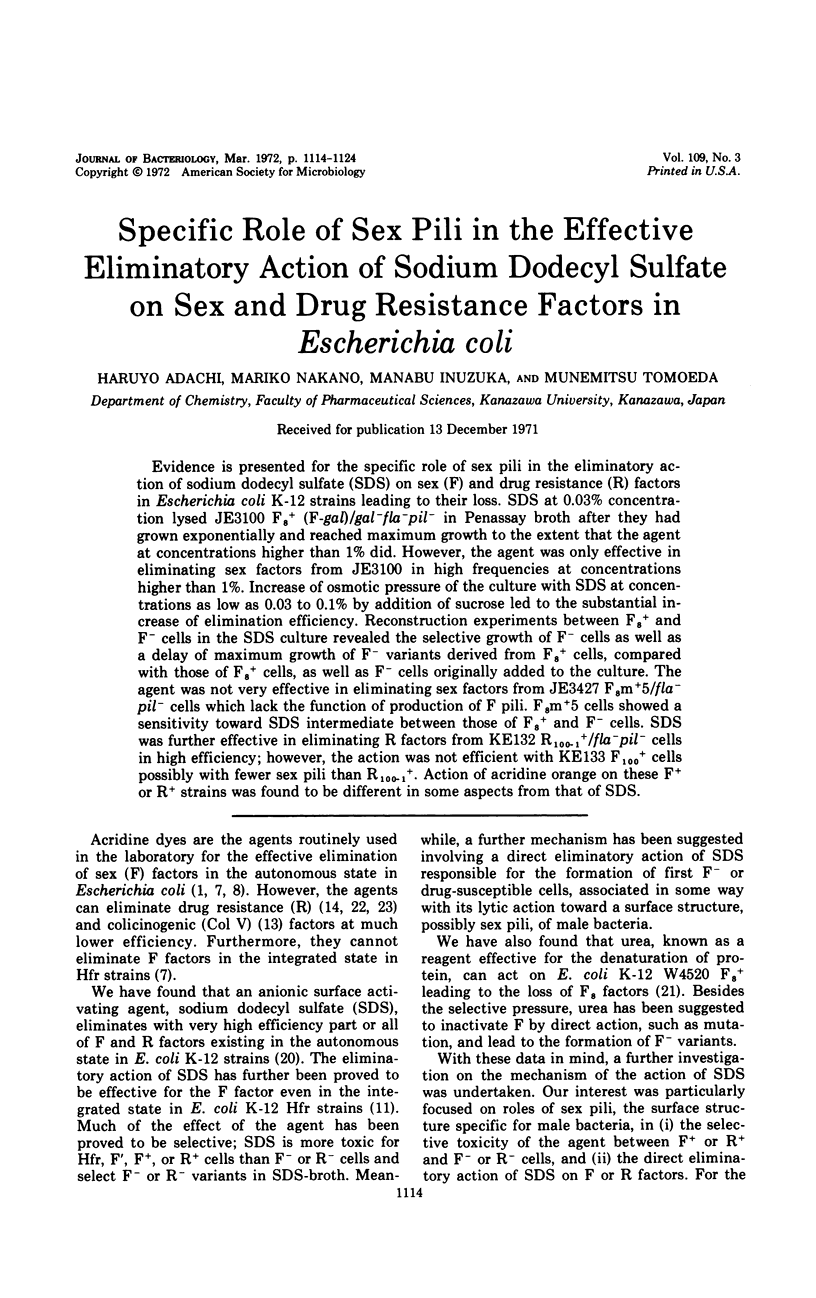
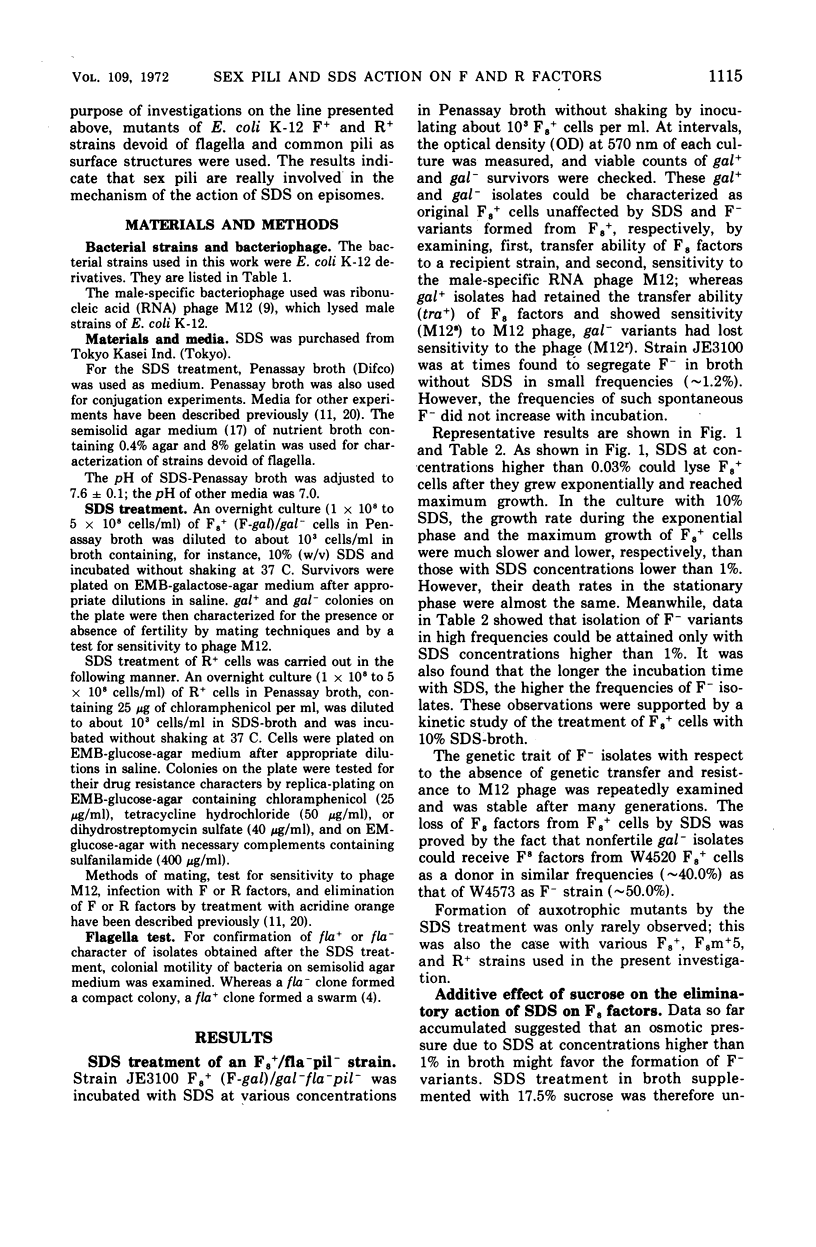
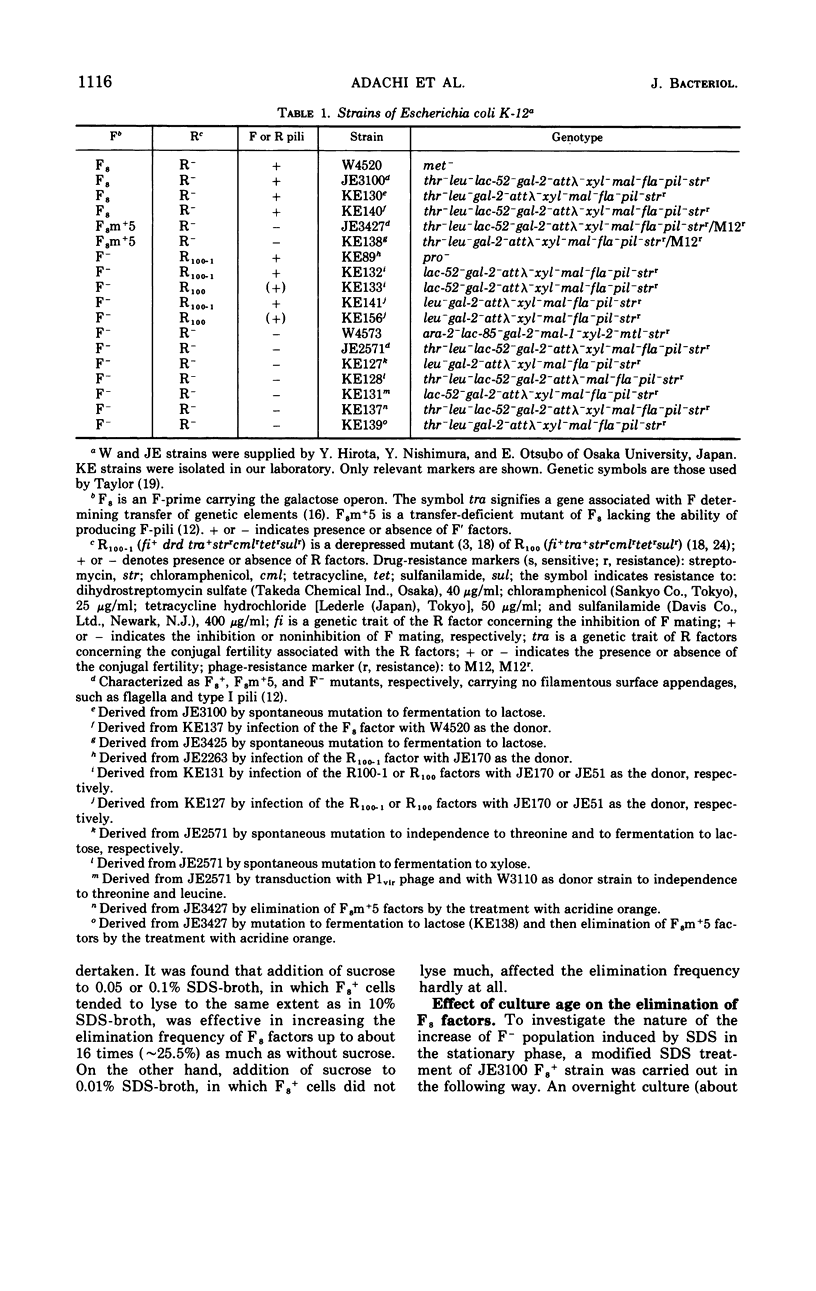



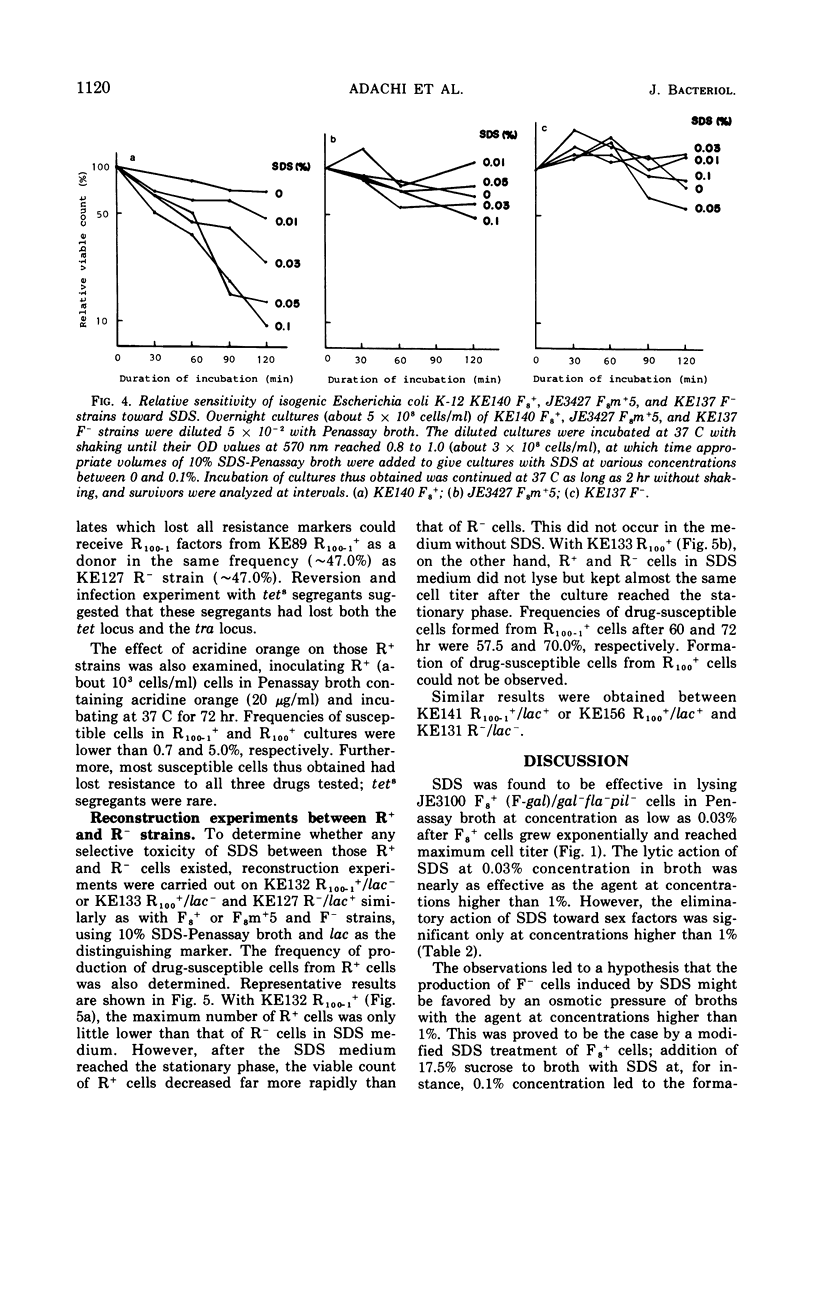
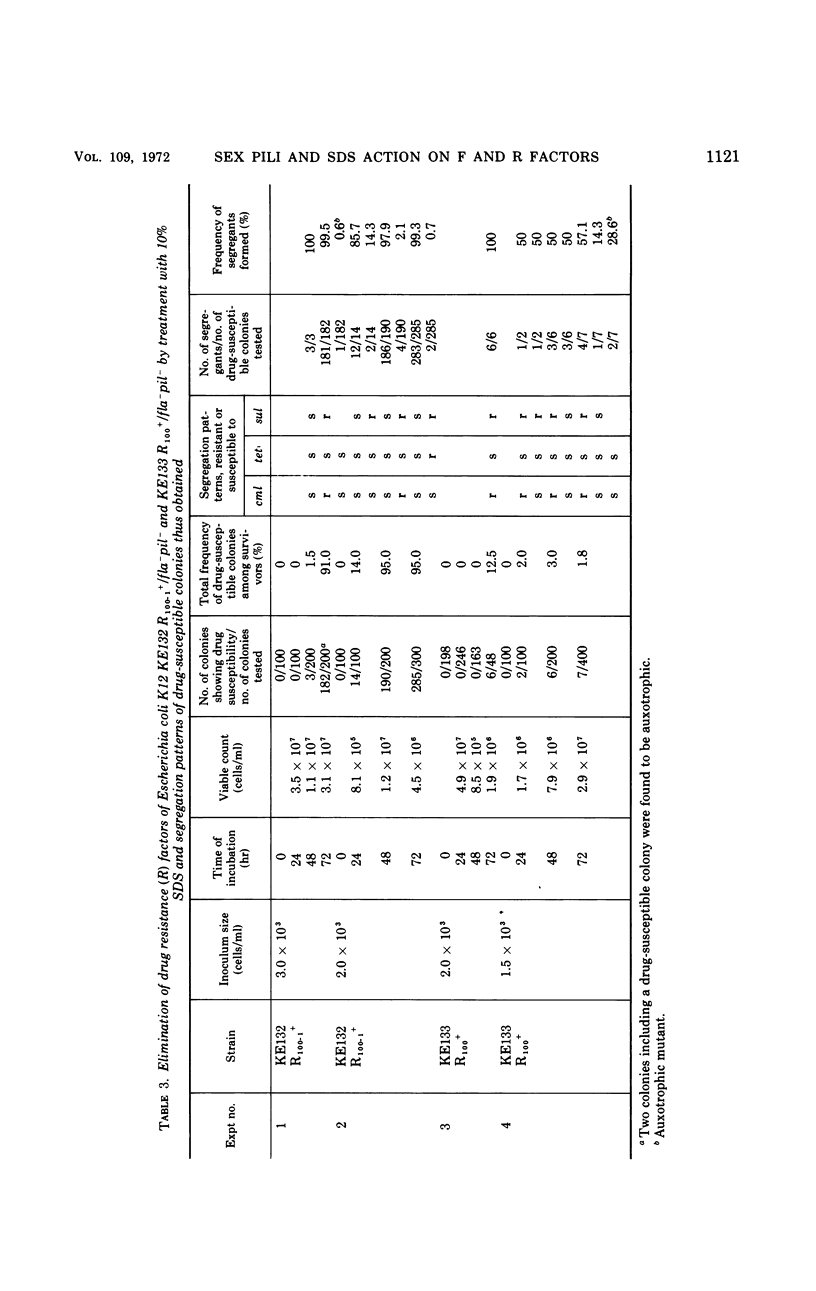
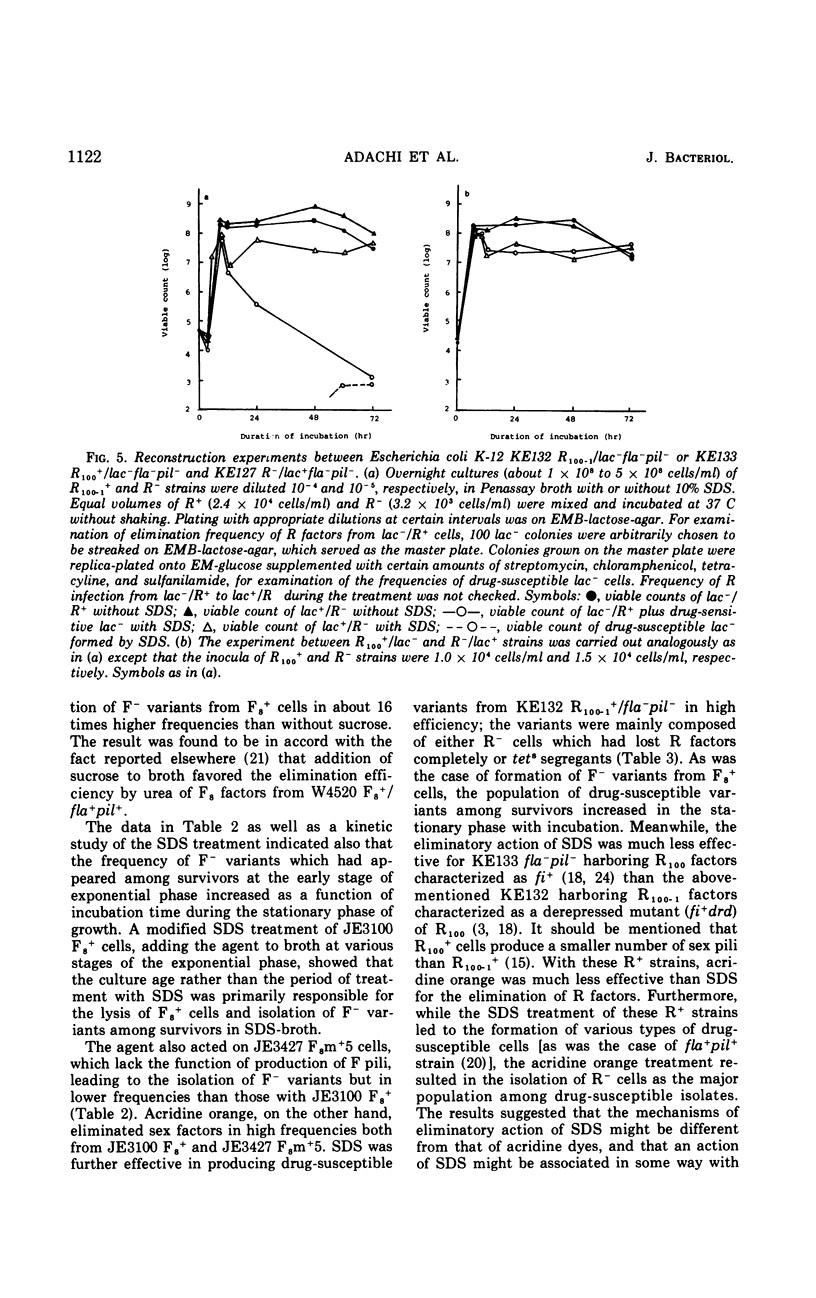

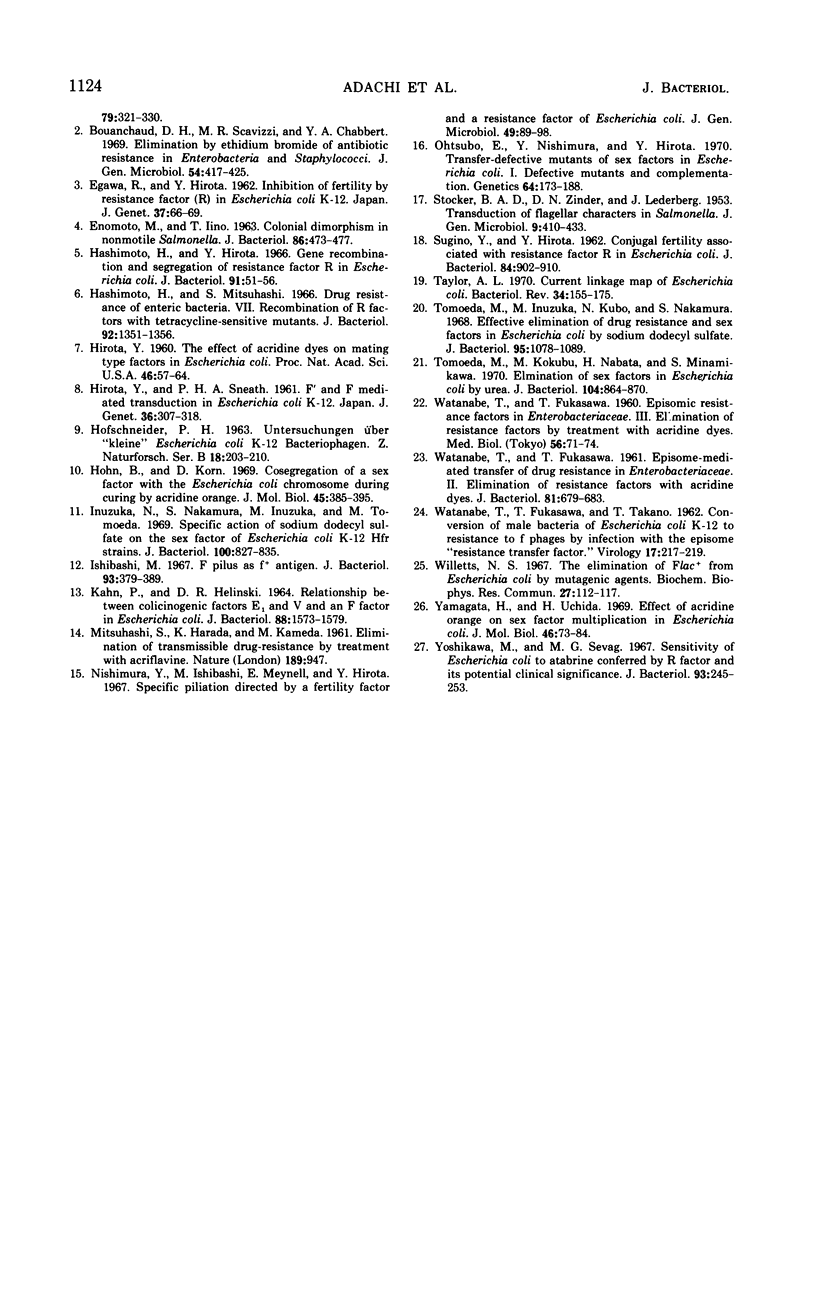
Selected References
These references are in PubMed. This may not be the complete list of references from this article.
- Bouanchaud D. H., Scavizzi M. R., Chabbert Y. A. Elimination by ethidium bromide of antibiotic resistance in enterobacteria and staphylococci. J Gen Microbiol. 1968 Dec;54(3):417–425. doi: 10.1099/00221287-54-3-417. [DOI] [PubMed] [Google Scholar]
- ENOMOTO M., IINO T. COLONIAL DIMORPHISM IN NONMOTILE SALMONELLA. J Bacteriol. 1963 Sep;86:473–477. doi: 10.1128/jb.86.3.473-477.1963. [DOI] [PMC free article] [PubMed] [Google Scholar]
- Hashimoto H., Hirota Y. Gene recombination and segregation of resistance factor R in Escherichia coli. J Bacteriol. 1966 Jan;91(1):51–62. doi: 10.1128/jb.91.1.51-62.1966. [DOI] [PMC free article] [PubMed] [Google Scholar]
- Hashimoto H., Mitsuhashi S. Drug resistance of enteric bacteria. VII. Recombination of R factors with tetracycline-sensitive mutants. J Bacteriol. 1966 Nov;92(5):1351–1356. doi: 10.1128/jb.92.5.1351-1356.1966. [DOI] [PMC free article] [PubMed] [Google Scholar]
- Hirota Y. THE EFFECT OF ACRIDINE DYES ON MATING TYPE FACTORS IN ESCHERICHIA COLI. Proc Natl Acad Sci U S A. 1960 Jan;46(1):57–64. doi: 10.1073/pnas.46.1.57. [DOI] [PMC free article] [PubMed] [Google Scholar]
- Hohn B., Korn D. Cosegregation of a sex factor with the Escherichia coli chromosome during curing by acridine orange. J Mol Biol. 1969 Oct 28;45(2):385–395. doi: 10.1016/0022-2836(69)90113-2. [DOI] [PubMed] [Google Scholar]
- Inuzuka N., Nakamura S., Inuzuka M., Tomoeda M. Specific action of sodium dodecyl sulfate on the sex factor of Escherichia coli K-12 Hfr strains. J Bacteriol. 1969 Nov;100(2):827–835. doi: 10.1128/jb.100.2.827-835.1969. [DOI] [PMC free article] [PubMed] [Google Scholar]
- Ishibashi M. F pilus as f+ antigen. J Bacteriol. 1967 Jan;93(1):379–389. doi: 10.1002/path.1700930144. [DOI] [PMC free article] [PubMed] [Google Scholar]
- KAHN P., HELINSKI D. R. RELATIONSHIP BETWEEN COLICINOGENIC FACTORS E1 AND V AND AN F FACTOR IN ESCHERICHIA COLI. J Bacteriol. 1964 Dec;88:1573–1579. doi: 10.1128/jb.88.6.1573-1579.1964. [DOI] [PMC free article] [PubMed] [Google Scholar]
- MITSUHASHI S., HARADA K., KAMEDA M. Elimination of transmissible drug-resistance by treatment with acriflavin. Nature. 1961 Mar 18;189:947–947. doi: 10.1038/189947a0. [DOI] [PubMed] [Google Scholar]
- Nishimura Y., Ishibashi M., Meynell E., Hirota Y. Specific piliation directed by a fertility factor and a resistance factor of Escherichia coli. J Gen Microbiol. 1967 Oct;49(1):89–98. doi: 10.1099/00221287-49-1-89. [DOI] [PubMed] [Google Scholar]
- Otsubo E., Nishimura Y., Hirota Y. Transfer-defective mutants of sex factors in Escherichia coli. I. Defective mutants and complementation analysis. Genetics. 1970 Feb;64(2):173–188. doi: 10.1093/genetics/64.2.173. [DOI] [PMC free article] [PubMed] [Google Scholar]
- STOCKER B. A. Transduction of flagellar characters in Salmonella. J Gen Microbiol. 1953 Dec;9(3):410–433. doi: 10.1099/00221287-9-3-410. [DOI] [PubMed] [Google Scholar]
- SUGINO Y., HIROTA Y. Conjugal fertility associated with resistance factor R in Escherichia coli. J Bacteriol. 1962 Nov;84:902–910. doi: 10.1128/jb.84.5.902-910.1962. [DOI] [PMC free article] [PubMed] [Google Scholar]
- Taylor A. L. Current linkage map of Escherichia coli. Bacteriol Rev. 1970 Jun;34(2):155–175. doi: 10.1128/br.34.2.155-175.1970. [DOI] [PMC free article] [PubMed] [Google Scholar]
- Tomoeda M., Inuzuka M., Kubo N., Nakamura S. Effective elimination of drug resistance and sex factors in Escherichia coli by sodium dodecyl sulfate. J Bacteriol. 1968 Mar;95(3):1078–1089. doi: 10.1128/jb.95.3.1078-1089.1968. [DOI] [PMC free article] [PubMed] [Google Scholar]
- Tomoeda M., Kokubu M., Nabata H., Minamikawa S. Elimination of sex factors in Escherichia coli by urea. J Bacteriol. 1970 Nov;104(2):864–870. doi: 10.1128/jb.104.2.864-870.1970. [DOI] [PMC free article] [PubMed] [Google Scholar]
- WATANABE T., FUKASAWA T. Episome-mediated transfer of drug resistance in Enterobacteriaceae. II. Elimination of resistance factors with acridine dyes. J Bacteriol. 1961 May;81:679–683. doi: 10.1128/jb.81.5.679-683.1961. [DOI] [PMC free article] [PubMed] [Google Scholar]
- WATANABE T., FUKASAWA T., TAKANO T. Conversion of male bacteria of Escherichia coli K12 to resistance to f phages by infection with the episome "resistance transfer factor". Virology. 1962 May;17:217–219. doi: 10.1016/0042-6822(62)90108-3. [DOI] [PubMed] [Google Scholar]
- Willetts N. S. The elimination of Flac+ from Escherichia coli by mutagenic agents. Biochem Biophys Res Commun. 1967 Apr 7;27(1):112–117. doi: 10.1016/s0006-291x(67)80048-2. [DOI] [PubMed] [Google Scholar]
- Yamagata H., Uchida H. Effect of acridine orange on sex factor multiplication in Escherichia coli. J Mol Biol. 1969 Nov 28;46(1):73–84. doi: 10.1016/0022-2836(69)90058-8. [DOI] [PubMed] [Google Scholar]
- Yoshikawa M., Sevag M. G. Sensitivity of Escherichia coli to atabrine conferred by R factor and its potential clinical significance. J Bacteriol. 1967 Jan;93(1):245–253. doi: 10.1128/jb.93.1.245-253.1967. [DOI] [PMC free article] [PubMed] [Google Scholar]


